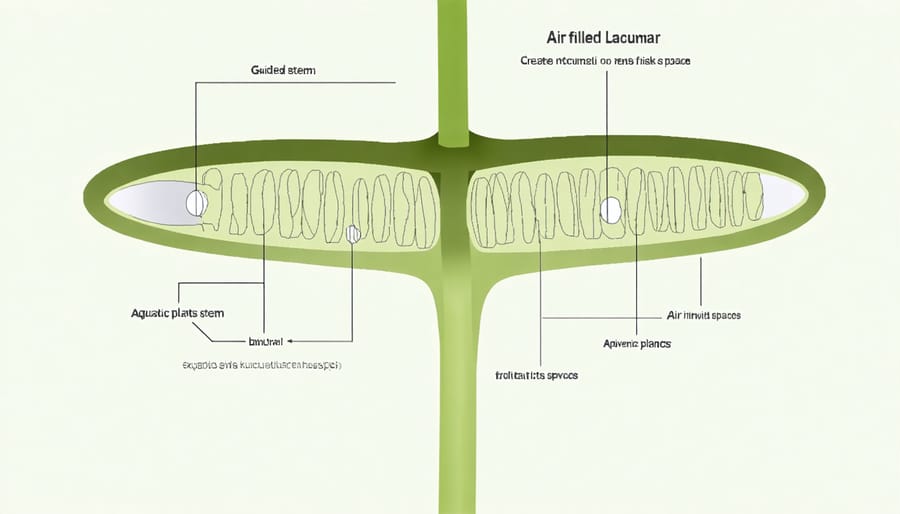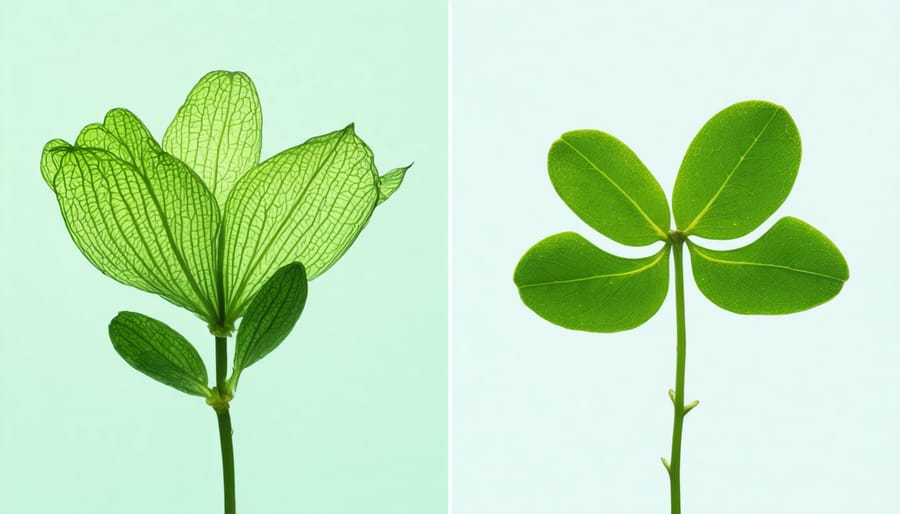
7 Incredible Adaptations That Let Aquatic Plants Thrive Underwater
From the depths of the ocean to the tranquil waters of your backyard pond, underwater plants have evolved remarkable adaptations to thrive in their submerged environments. Just as ocean plant adaptations have unlocked the secrets of aquatic survival, understanding these adaptations can help you create a thriving and visually stunning water garden. Dive into the fascinating world of underwater plant adaptations and discover how these marvels of nature can transform your pond into a mesmerizing aquatic oasis.
Thin, Flexible Leaves
Many underwater plants have evolved to have thin, ribbon-like or finely dissected leaves that allow them to thrive in their aquatic environment. These specialized leaf structures help the plants absorb more light in the dim underwater conditions. By having a larger surface area, the leaves can capture more of the limited sunlight that filters through the water, enabling photosynthesis and growth. Additionally, the thin and flexible nature of these leaves reduces drag in moving water. As currents flow past the plant, the leaves can bend and flow with the water rather than resisting it. This adaptation prevents damage to the delicate leaves and allows the plant to conserve energy. Some examples of underwater plants with these leaf adaptations include eelgrass, water sprite, and hornwort. Their graceful, flowing leaves not only serve a functional purpose but also add to the aesthetic beauty of aquatic landscapes. By understanding these adaptations, water gardeners can select the best plants for their ponds or aquariums and create thriving, visually appealing underwater gardens.


Lacunar Air Spaces
Many aquatic plants have evolved special air-filled cavities called lacunae within their stems and leaves. These lacunar air spaces play a crucial role in helping underwater plants survive and thrive. Since gases diffuse 10,000 times slower in water compared to air, lacunae act as an efficient internal transport system to move oxygen from the above-water portions down to the submerged parts of the plant.
Lacunae form an interconnected network of hollow channels that run through the plant tissues. Oxygen produced by photosynthesis in the leaves can enter these air spaces and travel downward to reach the roots and other underwater structures. This adaptation allows vital oxygen to bypass the limitations of diffusion through water.
The presence of lacunae also provides buoyancy to aquatic plants, helping them stay afloat or maintain an upright position in the water column. Species like water lilies and lotus rely on lacunar air spaces in their thick, spongy stems to support large floating leaves on the surface.
In some plants, lacunae can even store oxygen to help survive periods of complete submergence or low light conditions when photosynthesis is limited. This reserve supply sustains cellular respiration in submerged tissues until the plant can access air again.
So next time you admire the graceful foliage of aquatic plants, remember the unsung hero within – those tiny air pockets called lacunae quietly working to keep the entire plant oxygenated and thriving underwater. Nature’s ingenuity at its finest!
Reduced Cuticles
Most terrestrial plants have a thick, waxy cuticle layer on the surface of their leaves to prevent water loss. However, underwater plants have adapted to life in an aquatic environment by developing much thinner cuticles. This allows them to absorb dissolved nutrients and gases directly from the surrounding water through their leaf surfaces. The thin cuticle layer enables efficient uptake of essential compounds like carbon dioxide, which is typically less abundant in water compared to air. By reducing the barrier between their leaves and the water, submerged plants can access the resources they need to photosynthesize and grow. This adaptation is particularly important in still or slow-moving waters where nutrients and gases may be more limited. The reduced cuticle thickness also helps underwater plants remain flexible and less prone to damage from water currents or aquatic life. So next time you admire the graceful leaves of a submerged plant, remember that their thin cuticles are a key adaptation that allows them to thrive in their watery world.
Holdfast Structures
Many aquatic plants have developed specialized root-like structures called holdfasts that anchor them securely to rocks, sediment, or other underwater surfaces. Unlike terrestrial plant roots that primarily absorb water and nutrients from soil, holdfasts serve a crucial role in providing stability and preventing plants from being swept away by currents or turbulence. These adaptations come in various forms, such as disc-shaped pads, branching rhizoids, or even cement-like secretions. For instance, giant kelp, a type of seaweed, has a massive holdfast that resembles a tangle of roots, allowing it to grip tightly to rocky substrates and withstand powerful ocean swells. Similarly, sea grasses often have extensive networks of rhizomes that spread horizontally through the sediment, anchoring the plants while also facilitating vegetative reproduction. By evolving these sturdy holdfast structures, aquatic plants have successfully adapted to the unique challenges of the underwater environment, ensuring they remain firmly in place to absorb nutrients, photosynthesize, and thrive in their submerged habitats. So the next time you observe a graceful kelp forest swaying with the currents or a tranquil seagrass meadow, remember the vital role of their hidden holdfasts in maintaining the stability and resilience of these fascinating underwater ecosystems.
Pressurized Gas Flow
Some aquatic plants have developed specialized mechanisms to actively pump oxygen down to their submerged roots and stems, enabling them to thrive in oxygen-poor underwater environments. These plants have air spaces called aerenchyma that act as channels to transport oxygen from the leaves down to the roots. The oxygen is generated through photosynthesis in the above-water leaves.
To pump the oxygen against the water pressure, some plants like water lilies use pressurized flow. The leaves have tiny pores called stomata that can open and close. When open, they allow oxygen to enter the aerenchyma. As photosynthesis continues, oxygen builds up and increases the pressure in these channels.
This pressure forces the oxygen to flow down to the submerged parts that need it. The constant production of oxygen in the leaves maintains this pressure gradient. Specialized cells help regulate this flow. This adaptation ensures the roots and other submerged structures receive vital oxygen, even when buried in oxygen-depleted substrate at the bottom of a pond or lake.
Thanks to pressurized gas flow, these plants can grow extensive root systems in underwater soil and absorb nutrients to support their impressive growth and beautiful floating leaf pads and flowers we admire on the water surface.
Heterophylly
Some aquatic plants have evolved an incredible adaptation called heterophylly, allowing them to produce two distinct types of leaves for different environments. Underwater, these plants grow finely dissected, thread-like leaves that minimize resistance to water flow while maximizing surface area for efficient nutrient absorption. However, the leaves that emerge above the water’s surface are much broader and flatter, resembling those of terrestrial plants. This clever design enables the above-water leaves to capture as much sunlight as possible for photosynthesis, while the submerged leaves focus on absorbing dissolved nutrients and carbon dioxide from the water. Well-known examples of heterophyllous aquatic plants include water buttercups, many species of Potamogeton, and the aptly named “mermaid weed” (Proserpinaca palustris). When selecting stunning water plants for your pond or aquarium, keep an eye out for these marvels of adaptation that showcase nature’s ingenuity in creating specialists for both underwater and above-water environments. By understanding how heterophylly works, you can better appreciate the unique beauty and functionality of these aquatic wonders and create a more diverse, thriving ecosystem in your own water garden.

Conclusion
In summary, the incredible adaptations of underwater plants, from modified leaves and stems to specialized roots and reproductive strategies, enable them to not only survive but thrive in the challenging conditions beneath the water’s surface. As we’ve seen, these plants have evolved in remarkable ways to capture sunlight, exchange gases, anchor themselves, and propagate in their aquatic environments. So the next time you admire the serene beauty of pond plants in a water garden or natural setting, take a moment to appreciate the amazing adaptations that allow such biodiversity to flourish in the depths. By understanding and celebrating these marvels of nature, we can create even more beautiful and thriving aquatic habitats in our very own outdoor spaces.
